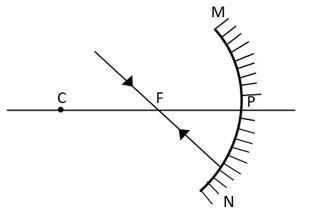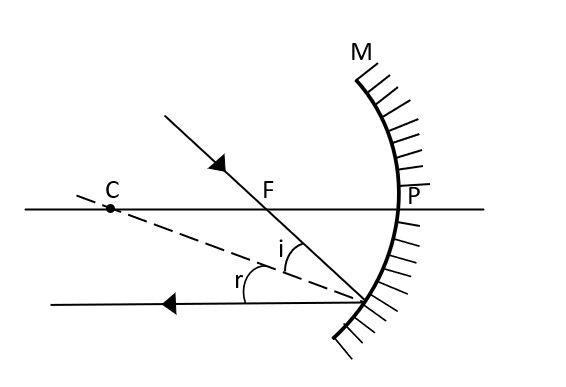
The ray diagram shown below is introduced to show how a concave mirror forms an image of an object:
a) Identify the mistake and draw the correct ray diagram.
b) Write the justifications for your corrections.


Answer
588.3k+ views
Hint: First, we will see that whether the incident ray is intersecting the principle axis or is parallel to it. In the question the given ray is intersecting the principal axis at the focal point and if an incident ray passes through the focal point of the concave mirror, upon reflection, becomes parallel to the principal axis.
Complete step-by-step answer:
a) We know that an incident ray passes through the focus of the concave mirror, after reflection becomes parallel to the principal axis of the mirror whereas in the diagram given in the question the reflected ray passes through the focus.
The correct ray diagram is as follows

b) We know from the laws of reflection that when a ray of light falls on a mirror at some angle, it bounces back with the same angle. Here also, the line through the center of curvature of the mirror acts as the normal at the point of incidence. So, after reflection, the reflected ray will be parallel to the principal axis.
Additional information:
The rules of reflection for concave mirrors an incident ray parallel to the principal axis of the mirror, after reflection passes through the focus of the mirror an incident ray passing through the focal point of the mirror, after reflection travels parallel to principal axis.
Note: The reflected ray will pass through the focus only when the incident ray is parallel to the principal axis. The line joining the centre of curvature and the point of incidence will act as normal at that point. Thus, we can trace the reflected ray using the concept that angle of incidence and angle of reflection are always equal for a mirror.
Complete step-by-step answer:
a) We know that an incident ray passes through the focus of the concave mirror, after reflection becomes parallel to the principal axis of the mirror whereas in the diagram given in the question the reflected ray passes through the focus.
The correct ray diagram is as follows

b) We know from the laws of reflection that when a ray of light falls on a mirror at some angle, it bounces back with the same angle. Here also, the line through the center of curvature of the mirror acts as the normal at the point of incidence. So, after reflection, the reflected ray will be parallel to the principal axis.
Additional information:
The rules of reflection for concave mirrors an incident ray parallel to the principal axis of the mirror, after reflection passes through the focus of the mirror an incident ray passing through the focal point of the mirror, after reflection travels parallel to principal axis.
Note: The reflected ray will pass through the focus only when the incident ray is parallel to the principal axis. The line joining the centre of curvature and the point of incidence will act as normal at that point. Thus, we can trace the reflected ray using the concept that angle of incidence and angle of reflection are always equal for a mirror.
Recently Updated Pages
Master Class 12 Business Studies: Engaging Questions & Answers for Success

Master Class 12 Economics: Engaging Questions & Answers for Success

Master Class 12 English: Engaging Questions & Answers for Success

Master Class 12 Maths: Engaging Questions & Answers for Success

Master Class 12 Social Science: Engaging Questions & Answers for Success

Master Class 12 Chemistry: Engaging Questions & Answers for Success

Trending doubts
What are the major means of transport Explain each class 12 social science CBSE

Which are the Top 10 Largest Countries of the World?

Draw a labelled sketch of the human eye class 12 physics CBSE

Explain sex determination in humans with line diag class 12 biology CBSE

The pH of the pancreatic juice is A 64 B 86 C 120 D class 12 biology CBSE

Explain sex determination in humans with the help of class 12 biology CBSE




